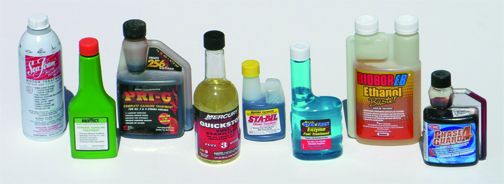If you’re putting your boat into storage this winter, one of the simplest jobs you can do to save you headaches next spring is to make sure youve treated your fuel system for storage.
For owners of diesel engines, you want to protect your tank against biological growth-primarily fungus and bacteria. For owners of gasoline powered boats-the bad side-effects of ethanol fuel are your chief enemy.
Our test of biocide treatments safe for diesel fuel appeared in July of 2009, with Biobor, Racor, Starbrite, and Valvtect all rating well.
And for those with gasoline engines, the problems with ethanol (see below) require a specialized product. The August 2012 has an update on our test of ethanol fuel additives for marine engines. BioborEB again proved its superior ability to fight corrosion. Sta-Bil Marine Formula, Star Tron, and Mercury QuikStor (the most expensive treatment, by far) picked up recommendations. Sea Foam came in as the low-budget contender.
Ethanol has added a whole new twist to the fuel storage game, and since many of our readers are still rely on good ol Atomic Four gas engines, and most of us have outboards to care for, Ive included some relevant background information on the problems with E-10 fuel and why we need to take fuel storage seriously.
Phase Separation
For many years, methyl tert-butyl ether (MTBE) was the oxygenate of choice for reformulated gasoline. MTBE was very soluble in gasoline, forming a stable blend with physical properties consistent with conventional gasoline. MTBE was also found to contaminate groundwater. For this reason, it was removed from the nations reformulated gasoline pool.
Switching to E-10 brought some unintended consequences, not the least of which was the process called cooling-induced phase separation, a process by which typically 1 to 3 percent and potentially 8 percent of the fuel can precipitate to the bottom of the tank. Heres how it works:
Ethanol is soluble in gasoline only if the alcohol is very dry. Unfortunately, the mixture is hygroscopic, drawing water from the air. In addition, the blend can become unstable when the temperature drops with the change of seasons. During the day, as the temperature rises, ethanols vapor pressure increases markedly. In fact, E-10 begins to boil at a mere 95 to 105 degrees Fahrenheit. (MTBE gasoline, by comparison has a far more stable vapor pressure.) These rapid changes in vapor pressure effectively act as a pump, drawing more humid air into the tank every night.
In addition, E-10 is an active absorbent. A half-full tank will become moisture saturated within 30 to 90 days, depending upon the temperature range and humidity. (Unless there is a leak, MTBE can collect water only from condensation, which is usually caught by a fuel/water separator.)
In E-10, the solubility of water decreases with temperature-0.6 percent is soluble at 85 degrees, but only 0.4 percent at 32 degrees-and when the solubility drops due to cooling, a portion of the water drops out of suspension, along with six times its volume in ethanol.
Tips for Storage of Ethanol Fuel
- Run only the highest-octane gas for your last tankful of the season, burning as much E10 out of the tank as safely possible to negate ethanol’s affinity for water absorption.
- If completely emptying the tank is not practical (empty tanks can increase fire risk), then fill the tank with non-E10 gas, leaving 10 percent room for expansion.
- Carefully stabilize the remaining fuel (check engine manufacturer for recommended stabilizer) and run the engine long enough so the stabilized fuel can circulate through the entire fuel system.
- When commissioning, fill the tank with high-octane fuel. Check fuel-water separators consistently. Have spare separators on board.









































So, for diesel fuel tanks, are you recommending filling the tanks to full or does it matter with diesel given it’s the growth of fungus and bacteria that’s at issue rather than the absorption of water from empty space as with gasoline?
If the diesel tank(s) are not full, will treatment such as Biobor or equivalent be sufficient in most cases?
Biocides are by definition toxins designed to kill the bugs (bacteria) that grow in fuel that contains even very small amounts of moisture/water. And of course those the residues of the biocides transfer into the rivers, lakes, ponds and seas where there continue killing organisms. It’s one of the ways that boating is harmful to our planet, most of which we can mitigate if we want. You gave two Pittman Awards to a much better solution that biocides, which are desiccant filters like H2Outs that are mounted in line on fuel vent lines. By removing the moisture in the fuel tanks and preventing more from getting in, they keep bacteria from growing in the first place. We haven’t had “bug” issues since we started using these 16 years ago. I think Practical Sailor needs to aim more carefully at solutions that are only partial.
Bravo! Well said and well reasoned. Thanks for bringing our short-sightedness into focus.